“The clock’s already ticking – some cases are already before the National Company Law Tribune,” said Sanjeev Sanyal, principal economic adviser to the finance ministry. “More lists will be out in the next few months.” Cleaning up India’s stressed loans is the biggest priority of Prime Minister Narendra Modi’s government, Sanyal said in an interview in New Delhi.
The Reserve Bank of India last week notified 12 large debtors against whom it had ordered banks to use bankruptcy laws to resolve Rs2tn ($31bn) or almost a fourth of the country’s bad debts. The process in these cases will be completed within a period of 90 days compared with 180 days in other cases, the government said.
For Modi, getting rid of the bad loans is crucial to reviving investments in Asia’s third-largest economy to meet his election pledge of adding jobs before the 2019 elections.
As concerns about slowing growth grow louder, India needs to resolve its debts mess and strengthen its lenders. Last month, the government gave the RBI new powers by amending the Banking Regulation Act. That enabled the central bank to order lenders to initiate insolvency proceedings against defaulters and create committees to advise banks on recovering non-performing loans. Using the bankruptcy law will ensure company founders and lenders renegotiate terms to resolve stressed loans within 180 days.
Resolving troubled loans will help the government plan capital infusion into state-owned lenders, Sanyal said. India plans to inject at least Rs100bn of capital into state-controlled lenders in the year ending March 2018 as it seeks to ratchet up credit growth. The RBI directive will negatively affect banks’ profitability over the next year if they need to take large write-downs relative to their existing loan-loss reserves, Alka Anbarasu, senior analyst at Moody’s Investor Service said in a note yesterday. However, the move is credit positive as it can help improve asset quality and set a precedent for resolving nonperforming loans from smaller borrowers, according to Moody’s. While it may not affect private-sector Indian banks given their strong profitability and capitalisation, weaker public-sector banks may require a large capital infusion from the Indian government, Moody’s said.
State banks will require about Rs800bn in equity capital over the next two years to support credit growth and to comply with global Basel III norms, ICRA Ltd, the local unit of Moody’s Investors Service had said in February.

